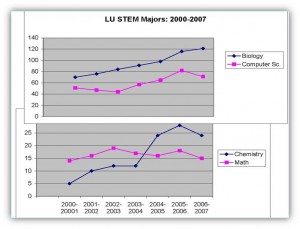LINC Results
LINC’s strategic activities aim to ensure that the project fulfills its mission of contributing to the to the number of minority students who select STEM as a major, complete an undergraduate degree in a STEM discipline, and enter and complete a graduate or professional degree program. Results show that it has achieved this goal, and also shows that it had broader impacts.
Its teaching and learning programs and processes serve the entire STEM student body. For instance, its Competency Performance Recordings for Learning (CPR-L) introduced an innovative teaching and learning strategy that enhances retention of subject matter and produces documentation of a student’s grasp of specific subject matter. Its STEM Digital Village has created a cyberspace community of information sharing that extends beyond Langston’s campus, and showcases achievements of LINC scholars. Its Research activities continue to be on point, providing significant research experiences for STEM majors for almost a decade.
One of the most salient contributions has been the increase in the number of scholars entering advanced degree programs. From 2000-2003 (pre-LINC), 19 LU STEM students entered advanced degree programs, 9 of which were MS/PhD programs. During the 2004-2007 period, thirty five (35) students entered advanced degree programs, 21 of which were MS/PhD programs.
Bottom line, there has been a 133% Increase in STEM Scholars Acceptance into MS/PhD Programs during LINC.
Enrollment in STEM majors increased during the LINC project compared to the pre-LINC period. Chemistry majors improved by 151%; Biology increased 46.7%, and Computer Science by 47.2 %.
Innovative teaching and learning, and communications tools, were created and introduced as a result of lessons learned during the LINC process. The Competency Performance Recordings for Learning (CPRL), an innovative teaching and learning process, has had a dramatic impact. Results are shown in the CPRL section.
An innovative communications and information dissemination tool, the STEM Digital Village (SDV), has revolutionized the way we share information internally and externally. Not only does it support an online community, but it contains strategic information that showcases accomplishments, serves as a PR tool, and has tools that support the pursuit of advanced degrees. Results are in the SDV section.
Research experiences have propelled LINC scholars to be recognized nationally for the content of their research projects, as well as the quality of their presentations. Results are in the Research section.


